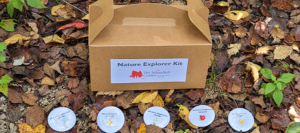COVID-19 has forced the Schuylkill Center to pivot and reimagine many of our programs. At the beginning of September, we began to reinvent our popular Schuylkill Saturday program so that families could explore our trails through self-guided activities available in Nature Kits. Every Saturday, Nature Kits have been given out on a first-come, first-served basis from 10:00 am–12:00 pm. Nature kits focus on a different theme each week and are meant to be done along our trails. Since the start of our nature kit program, we have seen more than 800 people come out and have handed out over 450 kits.
Starting this week, we are going to be featuring at-home versions of our popular Nature Kit activities so if you can’t make it out to the Center to pick up a kit, make sure to check our blog each week for ways to still get in some weekly nature exploration right where you are.
Animals in Winter
In the winter, temperatures drop and it gets really cold. In order to survive, animals will do one of three things: hibernate, adapt, or migrate. Animals such as bears and chipmunks will hibernate. This means that they curl up in a warm place, such as a cave or tunnel, and stay there until winter ends. Other animals, such as fox and deer, will adapt. To adapt means to use a special feature, such as a thick fur coat or stored food, in order to survive the cold temperatures. Lastly, to migrate means to travel to a warmer spot. Animals such as birds and even some marine mammals will migrate. Follow the directions for the activities below to learn more about hibernation, adaptation, and migration.
ACTIVITY #1: Squirrels and Adaptation
Squirrels are examples of animals that adapt in the winter. To stay warm in the winter, they will spend more time in their nests and less time out foraging—similar to us staying inside when it gets cold. Before winter starts, they will also bury food such as acorns. It can be hard to find food in the winter so squirrels will return to these stashes of food for something to eat throughout the winter.
- Draw a number of acorns on a piece of paper (Tip: Put a paperclip on them if it’s a windy day!)
- Hide them in either your backyard or a nearby park.
- Wait 5-10 minutes—and then see if you can find them all again.
- If you have real acorns around, you could do this same activity with real acorns—just make sure to mark them in some way (ex. wrapping a piece of yarn around them) so that you can tell them apart from other acorns.
- Take a moment to look around your backyard or a nearby park to see if you see any squirrels out and about.
- Are they digging up acorns that they buried before the winter?
- Try looking up in the trees for squirrel nests. Squirrel nests look like large bundles of leaves balanced between tree branches. They are often easier to see in the winter when there are no leaves on the trees.
ACTIVITY #2: Birds and Migration
Birds are an example of an animal that migrates. Birds migrate to warmer areas to find food and lay their eggs. Birds, however, often face challenges as they migrate. They rely on areas such as wetlands for food, rest, and shelter—similar to how we stop at rest stops and hotels when we travel. These areas though are oftentimes developed to make way for houses or shopping centers. Grab a piece of chalk and make a hopscotch board on a nearby sidewalk.
- Follow the bird migration hopscotch directions to play the bird migration game. If you don’t have chalk at home, try using a rock to draw a hopscotch board instead.
- Take a moment to look around for birds in your backyard or a nearby park.
- Although many birds migrate, some do stick around in the winter and will often change their diet depending on what foods are around.
- For example, birds that eat insects in the spring and summer may switch to eating more seeds, nuts, and berries in the winter when insects aren’t as readily available.
- What type of food do you see that is still around for these birds?
- Although many birds migrate, some do stick around in the winter and will often change their diet depending on what foods are around.
ACTIVITY #3: Bears and Hibernation
Bears, chipmunks, skunks, groundhogs, and snakes are all examples of animals that either enter true hibernation or something similar to it. Animals that hibernate usually find warm areas such as tunnels, burrows, or caves.
- Make a warm den outside for a stuffed animal that you have at home.
- Try to find a small crevice and use natural materials such as sticks and leaves to make it nice and warm.
- Besides warmth, try to think of some other features that would make for a good den (ex. shelter from rain or snow, hidden from potential predators, etc.).
- Take a moment to look around in your backyard or a nearby park. Can you locate some areas that would make for good places for animals to seek shelter or cover?
If you do any of these activities, be sure to snap a picture and share it with us on social media (tag us @schuylkillcenter)—we’d love to see what you discover in your own backyard!

